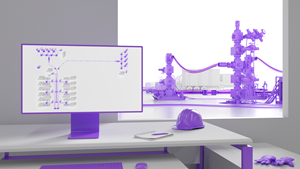Measuring frac completion efficiency by pump uptime is outdated—real performance demands a redefinition of what efficiency truly means. Reliance on automated control systems to maintain continuous pumping—essentially the performance of tasks remotely to minimize human intervention—does not substantially optimize throughput efficiency or lessen the scramble of transitions.

Instead, implementation of an autonomous pressure control ecosystem, especially in conducting simul-frac operations, is required to intelligently and autonomously control pressure and transitions.
Autonomous frac completions deliver smarter capabilities and more meaningful efficiency gains than just the implementation of automated continuous pumping.
A smarter metric for frac completion efficiency
First, a smarter metric needs to be defined for completion operations efficiency, which requires keeping in mind that this is not about controlling the frac; it’s about managing the wells and maximizing throughput. Sure, continuous pumping is easy to measure. But what is being continuously pumped and what is the time required?
TechnipFMC’s iComplete® high-performance surface pressure containment ecosystem is an autonomous, integrated platform that closes the loop between horsepower and the reservoir. It provides operators with the assurance of a continuous sand-flow guarantee—defined as proppant delivery to the fracture proceeds uninterrupted until the stage is complete. This reliability encompasses critical factors such as compatibility with all pumpers, the industry’s most dependable end connections, and autonomous operations that remove personnel from the red zone, among others.
Sand-flow efficiency, in turn, drives time efficiency by minimizing rig-up time and nonproductive time (NPT). Combined with the mitigation of failures and safety risks and improvements in sustainability and economics achieved with autonomous iComplete completion operations, these efficiencies help ensure frac job success—even when multiple stakeholders are present on location, which directly impacts the spread rate (i.e., the total daily cost of equipment and personnel).
From automation to autonomy: What’s the difference?
At TechnipFMC, we agree that automation is ideally suited for streamlining repetitive tasks, which does contribute to efficiency. But automation still requires micromanagement by the operator, whereas autonomous systems drive efficiency by reliably performing predefined sequences of repetitive tasks—whether at one or multiple wells or pads—independently of human intervention, which not only eliminates the likelihood of introducing error but also frees operators to focus on high-value strategic work.
Our iComplete high-performance surface pressure containment ecosystem enables full autonomy through its CyberFrac® digital backbone in combination with advanced missile and well systems to realize efficiency goals through operational security and outcomes, sand-flow efficiencies, and enhanced safety for personnel involved in high-risk activities.
Operators retain control within the digital CyberFrac autonomous platform as needed, while the iComplete ecosystem autonomously handles the numerous routine, highly configurable tasks of well completion operations, particularly across multistage pad-to-pad deployment and simul-fracs.
iComplete autonomy drives faster, safer, smarter simplification
In conjunction with its ecosystem design, iComplete deployment simplifies operations to boost efficiency by reducing connections by 90% and components by 50%, which contributes to operational efficiency through faster rig-up, fewer maintenance cycles, and less risk to the operational schedule, totaling 30% lower costs.
Key technology systems driving this efficiency are:
An additional attractive efficiency option is deploying the iComplete ecosystem with an electrical power system for greater operational sustainability while eliminating the NPT associated with hydraulic valve operation and the costs for diesel fuel and associated labor. Our electrical power system runs on absolutely minimal power drawn from the cushion generated for frac execution. By enabling the use of electric actuators with the iComplete ecosystem, failure modes are reduced by up to 90%. Electric-operated valve operation is highly predictable—8 seconds every time, regardless of temperature or location on the pad.
The power of less
Autonomous pressure-control systems enable unconventional operators to do more with less downtime, less manual oversight, and less personnel in critical pathways while achieving previously unobtainable efficiencies in sand slurry delivery. This shift to less equals more efficiency is critical as operators look to standardize and scale across their fleets for better results and economics.
Keep in mind: Autonomous technology isn’t about replacing people—it’s about improving operational performance by refocusing them to where they can make a true difference. The autonomous iComplete ecosystem can release two people per shift, per location. That’s four fewer daily commutes along with per diems and onsite risks—and just the labor cost alone, much less the risk avoided, can compensate for autonomous system implementation.
Rigorously tested for deployment globally
The autonomous iComplete high-performance surface pressure containment ecosystem was developed and proved in the highly demanding North American market and is seamlessly compatible with any pumper or fracturing unit provider. It’s now accessible for operators worldwide across emerging unconventional plays.
From proving concepts to scaling across operations, the iComplete ecosystem autonomously ensures 95%+ sand-flow efficiency, enabling productivity and safety improvement beyond mere automation-enabled results. Now is the opportunity for operators to move past the automation label to implement autonomy in well completions and achieve actual high-rate pumping efficiency with sand-flow continuity.
- 胡塞武装导弹袭击导致亚丁湾荷兰货船起火
- Equatorial Guinea boosts LNG production with Chevron Aseng agreement
- Solstad secures DeepOcean CSV extension
- Frac chaos out, autonomous control in
- Tamboran to Acquire Falcon Oil & Gas Ltd. to Create ~2.9-million-acre Beetaloo Basin Business
- Leadership change at United Heavy Lift as Bonnesen steps down
- Tamboran to acquire Falcon Oil & Gas, creating 2.9-million-acre Beetaloo basin leader
- DeepOcean secures Equinor SIMOPRO contract for Åsgard and Visund fields
- Reefer fleet on thin ice as majority fail carbon intensity tests
- Carsten Rehder inks $62m MPP order in India




